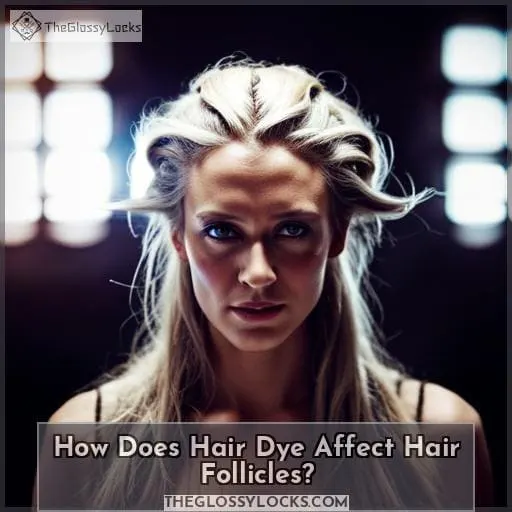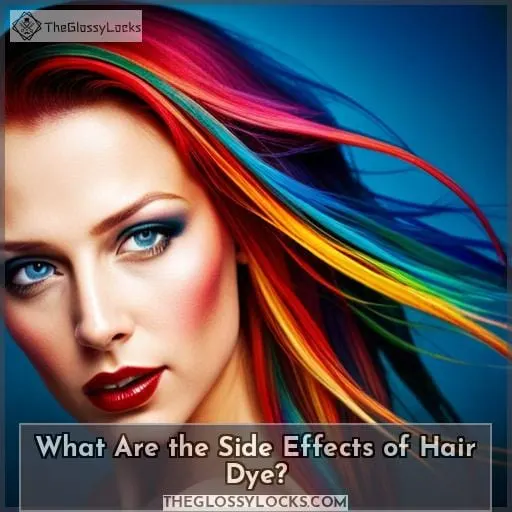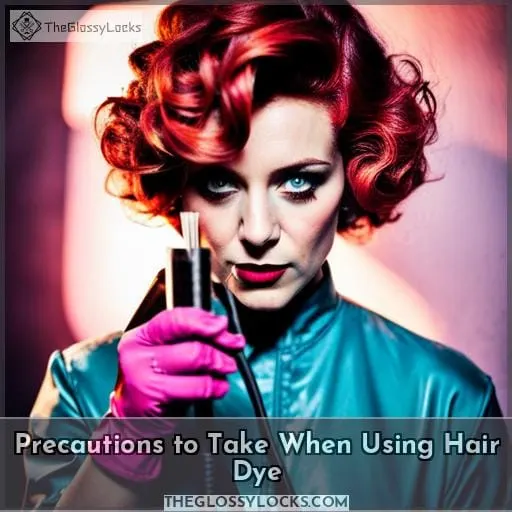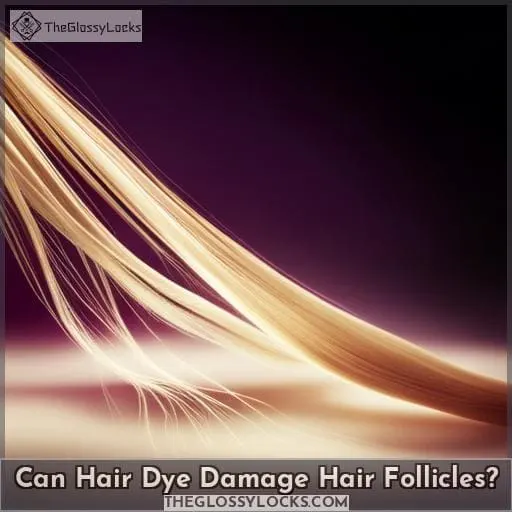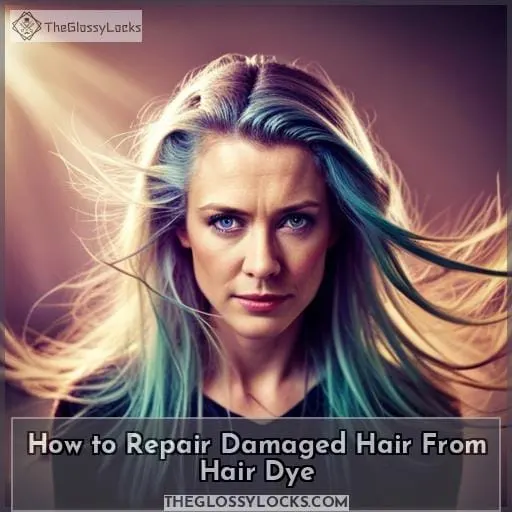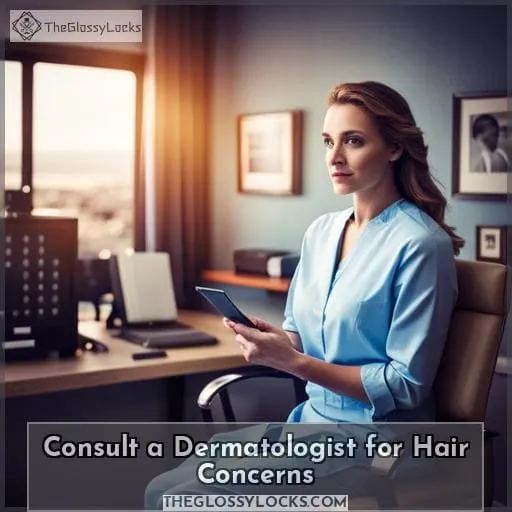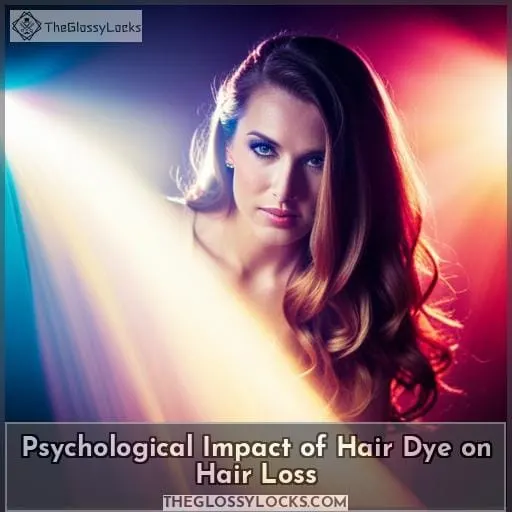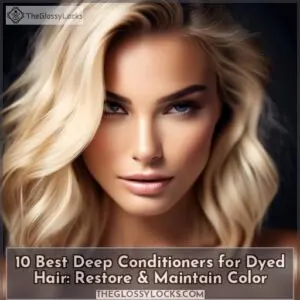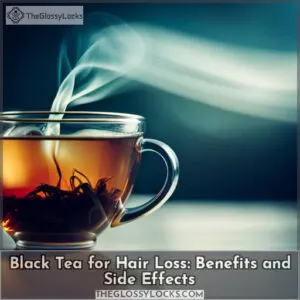This site is supported by our readers. We may earn a commission, at no cost to you, if you purchase through links.
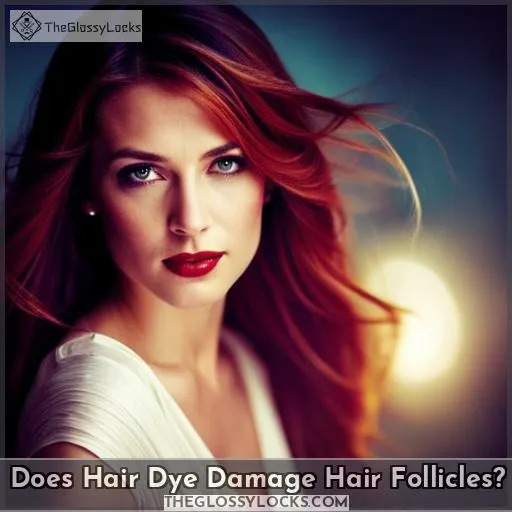 Are you curious about whether hair dye can damage your follicles? According to experts, it is a slippery slope – in some cases, the answer is yes. Hair dyes contain harsh chemicals that may cause chemical damage and weaken the shaft of your hair, which could lead to breakage or even loss of strands.
Are you curious about whether hair dye can damage your follicles? According to experts, it is a slippery slope – in some cases, the answer is yes. Hair dyes contain harsh chemicals that may cause chemical damage and weaken the shaft of your hair, which could lead to breakage or even loss of strands.
Don’t let this put a damper on your beauty routine though; there are precautions you can take to minimize any potential harm if you still want to color up! In this article, we will explore how exactly hair dye affects our follicles, as well as tips for replenishing and keeping healthy locks.
So buckle up and get ready for an enlightening journey into the world of hairstyling!
Table Of Contents
- Key Takeaways
- How Does Hair Dye Affect Hair Follicles?
- What Are the Side Effects of Hair Dye?
- Precautions to Take When Using Hair Dye
- Can Hair Dye Damage Hair Follicles?
- How to Repair Damaged Hair From Hair Dye
- Consult a Dermatologist for Hair Concerns
- Psychological Impact of Hair Dye on Hair Loss
- Conclusion
Key Takeaways
- Hair dye contains harsh chemicals that damage hair follicles.
- Permanent dyes with ammonia and hydrogen peroxide are the most damaging.
- Frequent dyeing weakens the hair shaft, leading to premature loss.
- Overuse makes strands brittle, causing breakage.
How Does Hair Dye Affect Hair Follicles?
Hair dyeing can be a great way to change your look, but it is important to keep in mind that the chemicals used can cause damage. The harshness of the chemicals may weaken hair shafts and lead to breakage, as well as premature hair loss.
Chemical Damage
Chemicals in hair dye can penetrate the scalp, affecting proteins and lipids to weaken follicles, potentially leading to breakage. Hair color damage from dyes may include chemical reactions caused by harsh ingredients, scalp health risks due to allergic reactions, altered texture as a result of fading or discoloration, and a decrease in color longevity over time.
Permanent dyes are more damaging than semi-permanent or temporary colors because they have higher levels of chemicals like ammonia and hydrogen peroxide that alter the structure of hair strands. To avoid damage, it’s best to use high-quality hair dye with natural ingredients such as silk protein conditioners that will replenish lost moisture for healthier strands.
Weakening of the Hair Shaft
Frequent dyeing can weaken your hair shaft and loosen follicles, potentially leading to premature hair loss. Permanent dyes are most damaging as they penetrate deep into the scalp, altering both the color and structure of the strands.
Prolonged use of chemical-filled dyes can also trigger allergic reactions such as skin irritation or discoloration. To reduce damage, conditioners containing milk protein or silk peptides should be used along with lipid-containing shampoos for repair.
Breakage and Hair Loss
Overusing hair dye can cause your strands to become brittle, leading to breakage and potentially premature hair loss. Hair dye may trigger allergic reactions, which could lead to scalp irritation or discoloration.
Use protective measures such as a patch test before applying the product and limiting treatments every six weeks. Choose quality products that match your natural color for minimal damage. Remember, conditioning dyes with silk or milk protein help reduce harm too! Speak with a dermatologist if you have any concerns about the effects of dyed hair on follicles and skin health overall.
Psychological impacts like depression, anxiety, and insecurity due to potential shedding should also be taken into account when considering coloring options. This is important in order to achieve liberation from negative emotions while still achieving desired aesthetic goals.
What Are the Side Effects of Hair Dye?
Are you considering changing up your hair color with a dye treatment? It may be best to consider the potential side effects of using hair dye, such as allergic reactions, skin irritation, and health risks.
Taking precautions before applying any type of product to your scalp is imperative in order to avoid unnecessary damage or discomfort.
Allergic Reactions
Be aware that allergic reactions to the harsh chemicals in hair dye can cause discomfort, even if you take precautions. Patch testing is essential before using hair dye to check for allergies and skin sensitivity.
Allergic reactions may include swelling, itching, or discolored skin; severe cases require immediate medical attention. Ammonia and hydrogen peroxide penetrate follicles, causing irritation and health risks such as endocrine-disrupting compounds linked to cancerous cells.
Skin Irritation
Using hair dye can cause skin irritation, so it’s important to be aware of any signs of discomfort. Chemicals like ammonia and hydrogen peroxide may penetrate the scalp, leading to sensitivity or rashes.
If you experience itching, swelling, or discoloration after using a product containing these chemicals, consult your dermatologist immediately. Follicle health is also at risk; frequent treatments weaken strands and make them vulnerable to breakage from scratching while styling or washing with chlorinated water in pools or baths.
Health Risks
Chemicals in hair dye can expose you to health risks, from skin irritation and allergic reactions to endocrine-disrupting compounds. Even natural or organic dyes may contain harmful substances that have been linked to negative impacts on your overall health.
Hair treatments like bleaching with peroxide cause oxidative damage and protein loss, while frequent dyeing weakens follicles leading to breakage. Allergic reactions such as swelling, itching, and discoloration require immediate medical attention.
It is recommended to do a patch test before using the product for prevention purposes.
Invest in deep conditioners for added protection against chemical damage and seek professional advice from board-certified dermatologists if necessary.
Precautions to Take When Using Hair Dye
It is important to take precautions when using hair dye in order to avoid potential damage. To start, you should always perform a patch test before applying the dye to check for allergies. Additionally, it’s beneficial to invest in high-quality dyes and limit your bleach usage as much as possible.
Patch Test for Allergies
To ensure a safe dyeing experience, make sure to perform an allergy patch test before starting. This is especially important if you have sensitive skin or are prone to allergic reactions.
To complete the patch test, apply a small amount of hair dye on your inner forearm and wait 24 hours for any signs of irritation or reaction. If there’s redness, itching, or swelling around the area, contact your dermatologist immediately for advice and further consultation.
Always be aware that even natural dyes can cause adverse effects due to their high content in proteins and lipids, which may damage hair structure when used frequently over time!
Use High-Quality Dyes
Investing in a high-quality dye can help reduce the risk of damaging your hair follicles. Choosing wisely is essential for maintaining healthy, vibrant locks. Select products suited to your hair type and color change intensity to minimize damage.
Consider allergic reactions when selecting dyes, as harsh chemicals like ammonia and peroxide can cause itching or skin discoloration if you’re sensitive. Products with conditioning ingredients such as silk protein or milk lipid are also helpful for reducing potential harm and nourishing strands long-term.
Limit Bleach Usage
Limit your bleaching sessions to preserve the health and strength of your hair. Reducing bleach exposure is key for maintaining follicle health, as it can damage protein and lead to allergic reactions.
When coloring, consider both color intensity changes and the products you’re using—using conditioning dyes with silk or milk proteins can help reduce damage. Protect from the sun, minimize heat styling tools like blow dryers and curling irons, and use a deep conditioner too! Lastly, perform patch tests before each application so any potential allergies are known beforehand.
Can Hair Dye Damage Hair Follicles?
Using hair dye can have a detrimental effect on your hair growth cycle, potentially leading to Telogen effluvium and weakening of the follicle. The chemicals present in dyes can cause oxidative damage to proteins and lipids that affect the structure of your hair, as well as potential allergic reactions or skin irritation.
Impact on Hair Growth Cycle
Understanding how hair dye affects your hair growth cycle is key to maintaining healthy and beautiful locks. Hair follicles can be weakened by the chemicals in some dyes, leading to breakage and loss. Anagen is the growth phase; Catagen is transitional; Telogen is resting. Chronic telogen effluvium causes shedding but not complete baldness from dyeing too often or using harsh products with alcohol or ammonia-based ingredients.
Dye allergies may cause itching that leads to loosened follicles, so patch tests are recommended before use.
Telogen Effluvium
Be aware that frequent hair dyeing can cause Telogen Effluvium, a drastic shedding of your mane like never before. Stress-induced shedding can occur when the hair growth cycle is disrupted by underlying causes such as medications or physical trauma.
Recovery periods vary depending on treatment options and how well you nourish your locks to strengthen them against further damage from dyes. To reduce the risk of Telogen Effluvium, consider limiting your use of chemical-laden products and seek professional assistance if symptoms persist.
Weakening of Hair Follicles
Frequent dyeing can weaken your hair follicles, leading to breakage and the possibility of premature hair loss. Allergic reactions to chemicals in dyes, such as ammonia or hydrogen peroxide, can also cause itching, which may lead to loosening of follicles if scratched.
Protecting scalp layers with conditioning shampoos before coloring and using natural colors are both ways you can keep your locks healthy while still having fun with color changes. Additionally, limiting treatments every 6 weeks is key for promoting long-term health of both skin and hair while minimizing psychological impacts from associated shedding.
How to Repair Damaged Hair From Hair Dye
When coloring your hair, it is important to choose a conditioning dye for the best results. Permanent and semi-permanent dyes are more likely to cause damage than temporary or natural dyes as they penetrate deep into the outer layer of hair follicles.
Conditioning Hair Dyes
Conditioning dyes can help reduce the damage to your hair follicles, so you can maintain healthy locks with minimal weakening. Allergy-prone people should use caution when dyeing their hair and always perform a patch test prior to using any product.
Natural conditioning agents, like silk or milk proteins, are used in some products. These agents help repair the damaged cuticle layer of each strand from harsh chemicals found in permanent and semi-permanent dyes.
Experts recommend applying conditioner regularly, minimizing heat styling tools, and using products specifically tailored for your hair type for optimal results.
To dye your hair safely, choose high-quality brands recommended by experts. Also, take steps to protect against allergies caused by ingredients found in many brands of dye available today.
Use of Lipid-Containing Shampoos
To restore hair health, try shampooing with lipid-containing products to replenish lost proteins and lipids. Lipid-infused shampoos are beneficial for color-treated hair as they help lock in moisture and protect against damage.
The fats in these shampoos can reverse the weakening effect of hair dye on follicles, preventing breakage and promoting healthy follicular growth. For the best results, choose shampoos with natural oils like olive or coconut oil.
These oils strengthen each strand of hair without stripping away its natural sebum barrier layer.
Deep Conditioning Treatments
Consider investing in deep conditioning treatments to replenish the health of your hair and protect it from further damage. A good deep treatment can help restore proteins, lipids, and structure weakened by hair dyeing.
Moreover, it can strengthen follicles and help prevent breakage due to chemical processes or allergic reactions.
Products containing silk or milk protein offer additional benefits as they reduce color fading for a longer-lasting effect without compromising on conditioning benefits.
Consult a Dermatologist for Hair Concerns
When it comes to concerns about your hair or skin, consulting a board-certified dermatologist is essential. Dermatologists and medical staff provide necessary treatments for hair damage caused by dyeing.
Board-Certified Dermatologists
For the best advice on hair concerns, turn to board-certified dermatologists who can provide specialized care and treatments. Their expertise is invaluable when it comes to diagnosing allergic reactions or understanding the psychological impact of hair dye ingredients.
Online consultations make accessing their services easy for those looking for quick answers about their health. Hair dye, if used incorrectly, can damage follicles leading to breakage and ultimately hair loss.
Dermatologists are trained professionals who know how chemicals in dyes interact with our scalp’s delicate ecosystem. They also understand what products work best with each individual’s unique needs! Seeking expert opinion from qualified specialists will give you peace of mind while keeping your locks healthy and beautiful at all times.
Necessary Treatments for Hair Damage
If you’re concerned about hair damage, a board-certified dermatologist can provide the necessary treatments. Treatment options include deep conditioning therapies to replenish moisture and proteins in your hair follicles.
They can also offer scalp micropigmentation for restoration. Preventing further damage is key, so schedule an appointment with a dermatologist to discuss follicle repair and potential PRP treatment if needed.
Regular trims may also be recommended. Damaged ends tend to break off more easily than healthy ones, leading to shedding that affects the overall growth of hair strands over time.
In addition, dermatologists can check for any allergies from dye chemicals. These allergies could cause itching or skin discoloration. Scratching can potentially loosen already weakened follicles prematurely, leading back into the cycle of baldness again.
Psychological Impact of Hair Dye on Hair Loss
You may be concerned about the psychological impact of hair dye on your hair loss, such as depression and anxiety caused by shedding. Limiting hair dye treatments to every six weeks can help reduce the risk of damage to your follicles.
Depression and Anxiety
The psychological effects of hair dye-related hair loss, such as depression and anxiety, can take a heavy toll on your mental health. Hair color choices can have an impact on emotional well-being. Understanding the damage that certain dyes may cause to follicles is important for maintaining healthy locks.
Coping strategies should be employed when faced with this type of stressor. From seeking professional help to simply taking better care of oneself. Mental health should not be taken lightly. If you feel that dyeing your hair might lead to negative consequences, it’s best not to take the risk.
Hair Shedding
Frequent hair coloring can dramatically diminish the health of your scalp and strands, potentially leading to persistent shedding. Hair dye ingredients like ammonia and hydrogen peroxide can weaken follicles, resulting in a decrease in color longevity.
Additionally, allergic reactions to dye chemicals, such as swelling and itching, may cause breakage or loosening of the follicle itself.
Your psychological wellbeing is also at risk with persistent hair loss due to cancer treatments or asthma symptoms being exacerbated by frequent coloring sessions.
Limiting Hair Dye Treatments
To keep your hair looking healthy, limit the number of times you dye it to every six weeks. Hair dyes can cause allergic reactions and weaken follicles over time, so reducing frequency is key for maintaining hair health.
Try using conditioning dyes with milk protein or silk proteins for added protection against damage from chemicals in the dye. Nourishing shampoos and conditioners are also important for replenishing lost lipids that protect from breakage while protecting your locks from chlorinated water when swimming.
In addition, it is highly recommended to do a patch test before coloring to check if you have an allergy towards any of its ingredients.
Conclusion
It’s estimated that 95% of Americans dye their hair. With so many people coloring their locks, it’s important to understand the potential effects of hair dye on hair follicles.
Hair dye can cause chemical damage, weakening of the hair shaft, and breakage and hair loss. Permanent dyes can penetrate deep and damage follicles, while semi-permanent dyes are gentler and often fade faster.
Hair loss due to hair dye can be avoided with proper care, such as using conditioning hair dyes, high-quality dye, and nourishing shampoo and conditioner. Consulting a dermatologist or scalp micropigmentation specialist is advisable if you have any concerns about your hair or skin.
Keeping these tips in mind will help you minimize potential damage to your hair follicles from hair dye.

